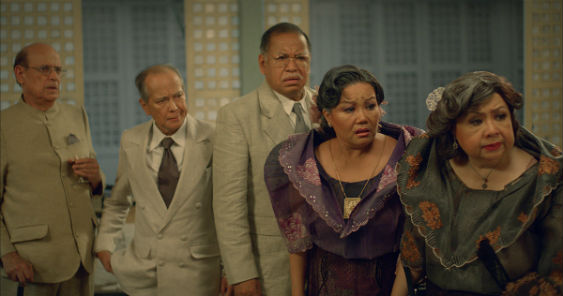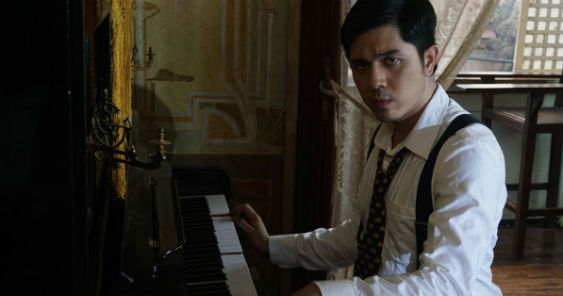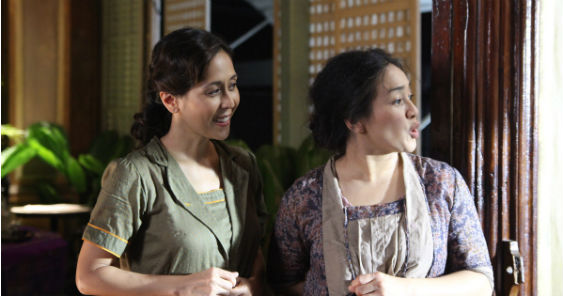MANILA – When we think of musical films in the Philippines, we often think of black and white films from the 1950s by LVN Pictures or Sampaguita Pictures where the protagonists spontaneously burst into song. Unfortunately, we also tend to recall of films from the 1980s to the 1990s where plots and story are cast aside for the sake of musical numbers where movie stars are tasked with belting out tunes (even those who should never be allowed near a microphone).
A true Filipino musical film, where the songs are composed specifically to advance the story, has usually seemed impossible to even comprehend these days due to producers not daring to take financial risks. They look at our movie-going public as people who would rather enter a cinema for cheap laughs or shallow jokes rather than have their brains stimulated or challenged. Thankfully, Loy Arcenas’ Ang Larawan dares to go down the road less traveled in Philippine cinema.
Based on National Artist for Literature Nick Joaquin’s 1952 play, “A Portrait of the Artist as Filipino,” it was eventually turned into a musical in 1997. With a libretto written by National Artist for Theater Rolando Tinio and music composed by Ryan Cayabyab, it took another 20 years for the film to make it to the big screen, but just in time for the 2017 Metro Manila Film Festival, Joaquin’s play has finally made the leap.
Set in 1941 in the walled city of Intramuros, the film chronicles the lives of sisters Candida (Joanna Ampil) and Paula (Rachel Alejandro) as fears of the Second World War are looming. Tasked with taking care of their father, renowned artist Lorenzo “El Magnifico” Marasigan, the unmarried sisters have no steady means of income, save for that brought in by boarder Tony Javier (Paulo Avelino). Their older, more successful siblings Manolo (Nonie Buencamino) and Pepang (Mencu Lauchengco-Yulo) urge the girls to sell their house as well as the final painting rendered by Don Lorenzo. The painting, a haunting masterpiece featuring the mythical Aeneas and his father, has been getting the attention of several prospective buyers.

Even their godfather, former poet-turned senator Perico (Robert Arevalo) wants the piece donated to the government in exchange for care for the siblings and their father. Several journalists begin surrounding the house, including family friend Bitoy Camacho (Sandino Martin). Javier himself is in contact with an American buyer, and he seduces Paula in hopes of getting her to let the painting go. As Manila prepares for air raids and blackouts, the girls recall a time when they would host parties in their home for society’s finest while their father was the toast of the town. The fate of the portrait, as well as that of the Marasigan household and Intramuros, seem intertwined as the Feast of the Lady of La Naval is about to be celebrated.
Keeping the film firmly in the 1940s, Cayabyab’s score uses music of the period when presenting performances for bodabil as well as the salsa and cha-cha moves of Elsa Montes (Zsa Zsa Padilla) and Charlie Dacanay (Rayver Cruz). It’s refreshing to see actual singers or actors with a musical background singing on the big screen, particularly veteran actors like Arevalo and performers like Buencamino, Lauchengco-Yulo, Ampil, Alejandro, and Celeste Legaspi. Balancing being in tune with acting is something we hardly see onscreen anymore these days, but thanks to films like Moulin Rouge and La La Land, it seems that film musicals are making a comeback globally.
There are several cameos in the film, and though they may distract you from the scenes, they are short and amusing enough to leave you chuckling instead of annoyed. Also, the gathering of veteran actors and singers from the 1980s such as Noel Trinidad, Nanette Inventor, Bernardo Bernardo, Dulce, and Jaime Fabregas during the film’s climactic scene bring another sense of nostalgia to a film that uses nostalgia in spades.

For a film industry with a rich history such as the Philippines, Ang Larawan is an ambitious project because it isn’t the usual campy releases with low budget effects and toilet humor that we’ve come to expect during the MMFF. To say that it is “high brow” is actually discriminatory against movies with actual substance because if one sits through this motion picture, at its core, the story is about a Filipino and the Philippines during a tumultuous period in our history. It is not a perfect movie, as the pacing could have been a little faster or some scenes taken out altogether, but in the face of the drivel that we see too frequently from local filmmakers, it easily stands out.
Most of us have probably heard of the stories about Ang Larawan being pulled out of cinemas due to low ticket sales during the festival. That continues to be a sad statement on the current state of Philippine cinema as well as the Filipino moviegoer. Still, if producers do not dare make films like Ang Larawan and either produce garbage or not make films altogether, then the film industry will continue to decline even further instead of reaching the lofty heights that this film is clearly aiming for.







